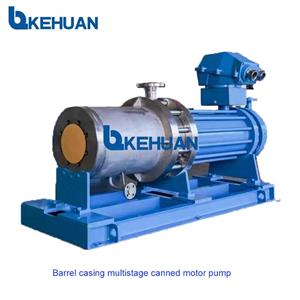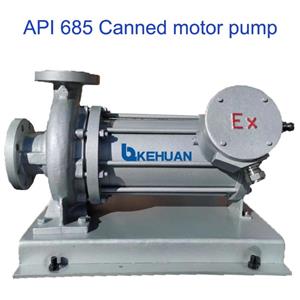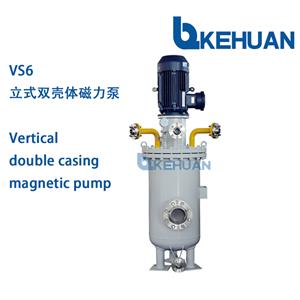Magnetic Process Pumps to the Extreme
From aquariums to acids, amines to ammonia, atomic particle accelerators to xylene, magnetic process pumps can be found in extreme conditions. This article explores the basic characteristics of mag-drive pumps (alloy and non-metallic) and their accompanying systems.
Magnetic pumps have evolved significantly from their early permutations in aquariums protecting costly Centropyge resplendens (Resplendent Angelfish). Today, magnetically coupled (mag-drive) pumps excel in acid service as an alternative to metallic mechanical seal components that tend to corrode. API mag-drives are ideal for amines and hydrocarbon services within refineries, and heavy duty alloy mag-drive pumps can safely pump hazardous liquid ammonia. The $9 billion Atomic Particle Super Collider at C.E.R.N. (Centre European Research Nuclear) in Geneva, Switzerland contains a cryogenic tunnel operating near absolute zero at 2 Kelvin (-271.15-deg C or -456-deg F) that includes refined alloy magnetically coupled pumps.
These are a few examples within the "A list" of liquefied toxins. Virtually all toxic chemicals on EPA's list of TRI (Toxic Release Inventory) regulated chemicals can be safely pumped at zero discharge levels with alloy or non-metallic magnetically coupled pumps, depending upon suitability of wetted pump materials.
As these examples demonstrate, mag-drive pumps are a versatile pump type. They feature zero emissions magnetic couplings, independent hydraulic ends and separate magnetic couplings near HP and torque. The independent motors of mag-drive pumps comply with plant requirements.
Mag-Drive Design and Standards
ISO-2858 Design Characteristics
Magnetic process pump designs closely follow ISO-2858 design parameters. The ISO design is essentially a DIN pump equipped with ANSI flanges. The technical advantages of ISO pumps include fully enclosed impellers that reduce axial thrust loads and provide safe operating clearances even under extreme temperature conditions. Improved hydraulic stability with lower velocities for ISO pumps abides by the "5-7 Velocity Rule" (i.e., 5-fps suction and 7-fps discharge), particularly at 3,500-rpm.
Lower NSS (Net Suction Specific Speed) values meet requirements for critical processes and refineries. Design tolerances for flow, head, efficiency and dimensions allow for direct interchangeability between ISO manufacturers. The extensive ISO hydraulic coverage ensures optimal efficiencies with numerous intermediate pump sizes, including 5-in, 6-in and 8-in nominal impellers, even in larger models.
API Foot and Centerline Pump Standards
The API-610 10th Ed. specification allows for foot mounted designs that provide dimensional interchangeability below 300-deg F (150-deg C). Centerline mounted pumps are recommended for higher temperatures in conventional overhung centrifugal pumps. However, mechanical seal run-out is a non-issue for mag-drive pumps. Close-coupled mag-drive pumps can handle up to 500-deg F, avoiding power frame and coupling alignment issues.
The API-685 sealless pump specification calls for centerline mounting but was intended for extreme high pressure and hazardous services.
Single and multistage alloy turbine process pumps can be built to API-610 10th Edition or API-685 specifications for low flow/high head requirements.
Alloy Mag-Drive (Centrifugal and Turbine) Specifications
Alloy Mag-Drive Applications
Alloy Sealless Pump Heat Induction Sources
Table 1 specifies the pump heat induction sources for alloy sealless pumps. Eddy current losses for both alloy mag-drive (rear casings) and canned motor pumps (isolation shells) reduce by the square of the speed (i.e., 1,750-rpm pumps have 25 percent of the losses generated at 3,500-rpm). VFD controls can offer rapid ROI for energy savings alone. Eddy current losses are linear to thickness that defines pressure, temperature, corrosion and breach resistance.
Motor heat induction inherent to canned motor pumps is constant regardless of speed, with residual heat present during off cycles. Auxiliary controls may be required for "low boilers" near the flash point.
Mag-Drive
Canned Motor
1) Eddy Current Losses
Permanent magnetic field
Electromagnetic field
2) Motor Stator Windings
n/a, (external motor)
TENV motor stator
3) Motor Armature Slippage
n/a, (external motor)
Internal pump rotor
4) Internal Bushing Friction
Negligible
Negligible
5) Internal Recirculation
Depends on pump sizing
Depends on pump sizing
Performance Ranges for Alloy Centrifugal and Turbine Mag-Drives
Alloy Centrifugal Mag-Drive Performance Range
- Continuous duty pumping in moderate to high flows
- Suitable for extremely hazardous or toxic liquids
- Flows up to 8- to 4,000-gpm (2- to 1,000-m3/hr)
- Heads up to 3,850-ft (1,173-m)
- System pressures from vacuum up to 7,250-psig (500-bar)
- Temperature from -150-deg F/-100-deg C to +650-deg F/343-deg C (840-deg F with heat exchanger)
Alloy Turbine Mag-Drive Performance Range
Continuous duty pumping in low to moderate flows
- Suitable for high differential or system pressure
- Handles up to 20 percent entrained gas and resists vapor locking
- Flows up to 45-gpm (10-m3/hr)
- Heads up to 3,250-ft (990-m)
- System pressures from vacuum up to 7,250-psig (500-bar)
- Temperature from -150-deg F/-100-deg C to +650-deg F/343-deg C (840-deg F with heat exchanger)
Low Flow Requirements for Centrifugal and Turbine Pumps
Low Flow Heat Induction and High Head Cavitation
Recirculation frictional heat of process liquid within centrifugal pumps operating below minimum stable flows cannot be avoided, regardless of impeller balancing or containment shell designs. Heat induction from internal recirculation can lead to high head cavitation from the energy that is imparted into the liquid. Insulating thermoplastic or fluoroplastic casing materials have a low rate of thermal conductivity.
Centrifugal Pump Flow Ratings
Centrifugal pumps are designed for moderate to high flows with the optimal efficiency at BEP (Best Efficiency Point). The accepted guideline for applying centrifugal pumps ranges from 10 percent to the right of BEP and 20 percent to the left. This guideline is used to ensure optimal hydraulic efficiencies and prevent both runout and high head cavitation.
Rise to Shut-Off and Flow Control
Turbine pumps are rated for continuous duty in low flow-high head systems. Variations in differential heads have minimal effect on turbine pump flow due to the high rise to shut-off. Dynamic turbine pump characteristics accommodate control valve regulation without bypassing. Suction strainers for turbine pumps are recommended (100 mesh size) if solid particulates are present and for start-up debris.
Non-Metallic Mag-Drive Specifications
Typical Applications for Non-Metallic Mag-Drives
The typical applications for non-metallic mag-drive pumps include all EPA monitored corrosive chemicals, corrosive acids (HCL, H2SO4, HF, nitric, phosphoric, acetic, etc.), caustics (sodium hydroxide, potassium hydroxide, etc.), chlorine, sodium hypochlorite, halogen solutions (chlorine, fluorine, bromine, hot HCL), high purity liquids and precious liquids.
Fluoroplastics and Thermoplastics
Permeation rates of non-metallic materials (fluoroplastics and thermoplastics) depend upon grade, thickness and density of pump material, concentration and temperature of process liquid, and system pressure. Mag-drive pumps equipped with fluoroplastic linings offer broad chemical resistance, but linings with 0.100-in to 0.125-in thickness require maintenance inspections following system upsets, cavitation, entrained solids or a "dropped magnet" from an internal bearing failure.
The mechanical characteristics of non-metallic pump materials are compromised with extreme temperatures (e.g., tensile strength with high temps, embrittlement with low temps, etc.).
Tensile strength curves
Machined Extruded Thermoplastics
Mag-drive pumps are available in machined extruded thermoplastics with higher density to resist permeation, or perforation due to higher casing wall thicknesses. However, alloy or lined steel piping must be properly supported, and flexible pipe connections may be required under extreme temperature cycling or variations.
Molded Thermoplastics
Molded thermoplastic components, particularly composite glass filled PP, can be attacked and permeated by many corrosive chemicals (e.g., caustics, chlorides, fluorides, bromides, etc.) due to etching and wicking of the glass fibers, leading to permeation. Molded thermoplastic casings with NPT threaded ports lack the necessary hardness to ensure a bubble-tight seal.
System Upsets and Monitoring
Run-out or High Head Cavitation
Mag-drive pumps should be supplied with minimum and maximum flow guidelines indicating safe continuous operating limits of the pump within the system parameters. For example, insufficient head is a primary source of centrifugal pump failures due to run-out conditions and spiking NPSH requirements. High head cavitation can occur when operating below stable minimum flows.
Dry-Running
Smaller pumps can be equipped with carbon bearings that provide intrinsic lubrication to withstand intermittent dry-running. Carbon is not practical for high capacity process pumps due to bearing loads. Diamond coatings for silicon carbide can provide limited protection until the surface coating is worn. Flow or power monitoring is the best protection to prevent dry-running.
Dead-Heading
Depending upon internal bearing circulation systems, intermittent dead-heading may be acceptable. Recommended operating limits should be specified by the manufacturer depending upon stability of process liquids.
Solids Handing
Mag-drive process pumps designed with product flush bearing circulation can be equipped with various API flush plans for managing solid particulates. Special consideration to the nature of the solids is required (e.g., percentage, hardness, size, ferrous, binding or non-binding, etc.). Proper flushing or filtering of the process piping system, prior to start-up, is typically recommended.
Monitoring Systems
Linear power monitors are an effective, non-invasive means of pump protection with the unique ability to detect cavitation. Flow metering may be preferred in processes with varying viscosities, specific gravities and temperatures. Temperature probes for alloy pumps offer protection against obstructed lubrication ports or interference of rotating components. Liquid sensing probes and sealing on adapter housings offer secondary containment.
https://www.pumpsandsystems.com




